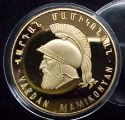Mamikonian

Vartan Mamikonian
Mamikonian or Mamikoneans was a noble family which dominated Armenian politics between the 4th and 8th century. They ruled the Armenian regions of Taron, Sasun, Bagrevand and others.
The origin of the Mamikonians is shrouded in the mists of antiquity. Moses of Chorene in his History of Armenia (5th or 6th century) claims that three centuries earlier two Chinese noblemen, Mamik and Konak, rose against their half-brother, Chenbakur, the Emperor of Chenk, or China. They were defeated and fled to the king of Parthia who, braving the Emperor's demands to extradite the culprits, sent them to live in Armenia, where Mamik became the progenitor of the Mamikonians.
The first known Mamikonid lord, or nakhararq, about whom anything certain is known was a certain Vatche Mamikonian (fl. 330-339). The family reappears in chronicles in 355, when the bulk of their lands lay in Tayk. At that point the family chief was Vasak Mamikonian, a commander-in-chief (sparapet) of Armenia. Later, the office of sparapet would become hereditary possession of the Mamikonians. Vassak Mamikonian was in charge of the Armenian defense against Persia but was eventually defeated through the treachery of Marujan Ardzruni (c. 367-368).
Following that defeat, Vasak's brother Vahan Mamikonian and multiple other feudal lords defected to the Persian side. The Emperor Valens, however, interfered in Armenian affairs and had the office of sparapet bestowed on Vasak's son Mushegh Mamikonian in 370. Four years later Varazdat, a new king, confirmed Musel in office. The latter was subsequently assassinated on behest of Sembat Saharuni who replaced him as sparapet of Armenia.
On this event, the family leadership passed to Mushegh's brother, Enmanuel Mamikonian, who had been formerly kept as a hostage in Persia. The Mamikonids at once broke into insurrection and routed Varazdat and Saharuni at Karin. Enmanuel, together with his sons Hemaiak and Artches, took the king prisoner and put him in a fortress, whence Varazdat escaped abroad. Zarmandukht, the widow of Varazdat's predecessor, was then proclaimed queen. Enmanuel came to an agreement with the powerful Sassanids, pledging his loyalty in recompense for their respect of the Armenian autonomy and laws.
Upon the queen's demise in 384, Enmanuel Mamikonian was proclaimed Regent of Armenia pending the minority of her son Arsaces III and had the infant king married to his daughter Vardandukh. It was Enmanuel's death in 385 that precipitated the country's conquest by the Persians in 386-387.
Another 5th-century Armenian historian, Pawstos Buzand, seconded the story. In his History of Armenia, he twice mentions that the Mamikonians descended from the Han Dynasty of China and as such were not inferior to the Arshakid rulers of Armenia. This genealogical legend may have been part of the Mamikonians' political agenda, as it served to add prestige to their name. Although it echoes the Bagratids' claim of Davidic descent and the Artsruni's claim of the royal Assyrian ancestry, some Armenian historians tended to interprete it as something more than a piece of genealogical mythology. A theory from the 1920s postulated that the Chenk mentioned in the Armenian sources were not the Chinese but probably from a different ethnic group from Transoxania, such as the Tocharians. Edward Gibbon in his The History of the Decline and Fall of the Roman Empire also believed that the founder of Mamikonian clan was not Chinese but merely from the territory of the Chinese Empire and ascribes a Scythian origin to Mamgon stating that at the time the borders of the Chinese Empire reached as far West as Sogdiana. Today, some historians are of the opinion that the Mamikonians were probably descended from chieftans of the Tzans (Chanik-in medieval Armenian, Tzannoi in medieval Greek). The Tzans were a tribe that once inhabited a mountainous region to the south of Trebizond. They postulate that the tradition of the Chinese origin arose out of the similarity of the name Chanik to the Armenian word for China, Chen-k.
Hamazasp Mamikonian was recorded as the family leader in 393. His wife is known to have been Sahakanoush, daughter of Saint Sahak the Great and descendant of the Arsacid kings. They had a son, Saint Vartan Mamikonian, who is revered as one of the greatest military and spiritual leaders of ancient Armenia.
After Vartan became Sparapet in 432, the Persians summoned him to Ctesiphon, forcing him to convert to Zoroastrianism. Upon his return to home in 450, Vartan repudiated the Persian religion and instigated a great Armenian rebellion against their Sassanian overlords. Although he died in the doomed Battle of Vartanantz (451), the continued insurrection led by Vahan Mamikonian, the son of Vartan's brother, resulted in the restoration of Armenian autonomy with the Nvarsak Treaty (484), thus guaranteeing the survival of Armenian statehood in later centuries. Saint Vartan is commemorated by an equestrian statue in Yerevan.
After the country's subjugation by the Persians, Mamikonians sided with the Roman Empire, with many family members entering Byzantine service. Not only did they rise to the highest offices of Constantinople, but even some of the emperors - conceivably Leo the Armenian and Basil I - could have been their descendants. Theodora the Byzantine regent and her brothers Bardas and Petronas the Patrician were also of Mamikonian heritage. Unsurprisingly, Mamikonians form a crucial link in the postulated descent of modern European nobility from antiquity.
No comments:
Post a Comment